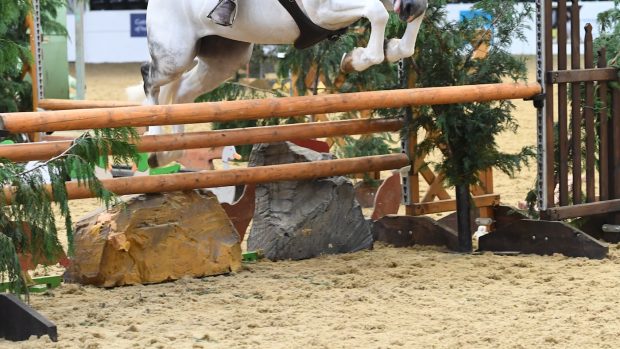More for action heros than pretty posers, the working hunter class is the closest you’ll get to eventing in a showring. Competitors tackle a round of jumps and are then put through their paces on the flat, making it an all-round test of a horse’s performance.
So what are the judges looking for?
1. Multiple Horse of the Year Show (HOYS) working hunter champion Louise Bell says practising the jumping at home is vital. “Get your horse used to rustic fences,” she says, explaining that even cross-country fences will do. “The most important thing is black water trays — even novice classes are likely to have one.” You don’t have to buy one but can improvise using a wooden board painted black or covered with black plastic bags. “Ride it like a normal fence,” Louise advises. “If you have problems, get off and try leading your horse over, even bribe him if necessary.” Other unusual fences that you might come across include narrow fences like a style, a pen where you have to jump in and jump out and, occasionally, a bullfinch.
2. Top judge Louise Daly, who has judged at everything from local shows to Royal Windsor, says: “I’m looking for a smooth round with the horse moving forward at all times. Judges like to see a good hunting pace, not a showjumping style where the horse is hooked back before a fence.” Louise’s pet hate is interrupting the rhythm to pull up and change legs. “The horse should be able to correct this for himself so just keep him balanced and kick on,” she advises.
3. Hunter judge Judy Bradwell insists that jumping style is important and a clear round doesn’t guarantee a good placing. “I like a horse that is bold, clever and athletic, but careful,” she says. “I prefer one that may tip a rail and have it down, to one that clonked every fence but went clear. Safety is key if it’s a horse you’d want to hunt.” In the case of a tie, the horse with better conformation will be marked above the one that jumped a clear round.
4. Bear in mind that a stranger will be riding your horse. If you are the only person who rides him, ask a friend to try him out. “He should go as well for someone else as he does for you, if not better,” say Louise Bell.
Continued below…

Demystifying 15 common conformation terms that not all horse owners are familiar with
5. “Good manners are vital,” says Louise Daly. “I look for a horse that rides light and is obedient. He should walk out without being niggled — if I’m going to hunt the horse all day, I want to ask for a change and know he will maintain it.”
6. Make sure there are enough holes in your stirrup leathers to accommodate a smaller or taller judge.
7. Check your stirrup irons are wide enough to safely fit a judge with bigger feet.
8. As the ride judge approaches, pull your horse forward a few strides out of line to allow them space for a leg-up.
9. Keep your tack simple and avoid overly-severe bits — if the judge sees you using a gag in the ring, they’ll wonder what you would need to stop your horse while out hunting.
10. “For the gallop it’s good to be forward, but I need to be able to stop. I don’t want to gallop three or four times round the ring — once is enough!” says Louise Daly. But at the other end of the speedometer, she has learnt not to force an unwilling horse forward. “Judging at one of my first shows I got on a horse that wouldn’t gallop,” she recalls. “In the end I booted it and it let rip and chucked me off in front of everybody. I felt about 2cm tall and learnt never to ask too much of a horse in the ring — if it doesn’t react as asked, mark it down and leave it at that.”
11. At the lower levels, you don’t need to do a flat-out gallop, an extended canter is enough. With novices it’s best not to over-practise this as they will anticipate and want to take off. Louise Bell recommends the following: “Increase the impulsion on the corner before the gallop and then ease the horse forward in front of the judges.”
12. Ultimately, judges like to see a horse that’s enjoying itself, got its ears pricked and is interested in what’s going on. Every aspect of the horse’s character, way of going and presentation contributes to the overall picture. “Things like having supple, beautifully cleaned tack really add to the first impression. Louise Bell always stands out for having immaculate, well-fitting tack and that is part of her success,” says Judy. Finally, make sure that your saddle and reins are supple and well-conditioned, but not oily or sticky.



